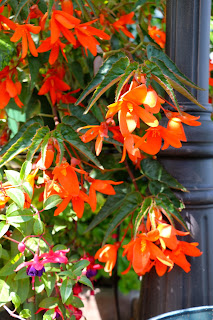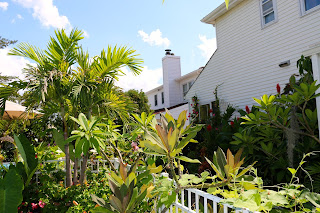So here is my underwhelming update of the best subtropicals in my yard in January.
My mahonia is a reliable winter bloomer. Buds appear in the Fall and flowers open up from February through March. The flowers are yellow which are a nice bright touch to dark winter days.
Speaking of bright - even when young Silver Mediterranean Fan Palms (chamaerops humilis var. cerifera) are very colorful with beautiful silver fronds. Mine has been in the ground for 5 years with minimal protection making it one of the hardiest palms I grow. It's a very slow grower though.
I also grow the common green form, Chamaerops humilis. They can easily tolerate temperatures below 20F so there beautiful fronds can be enjoyed most of the winter even in January. I have protected it only for 2 nights so far and in it's 6 years in New York, this palm has survived a temperature of 3 degrees!
Polystichum polyblepharum (aka Tassel Fern) is an evergreen fern hardy to zone 5. I have noticed some foliar damage with low temperatures only in the teens. So far it seems to be fully evergreen here in New York City. This fern is a beauty during the summer and not too bad looking during the winter. I recommend it!
The first of two plants that I left outside WAY longer than I wanted to, my Fatshedera lizei tree ivy. This plant is a hybrid between English Ivy and Fatsia Japconica. I left it outside in its tiny pot during an overnight low of only 10 degrees!! The whole thing was frozen solid and droopy when I took it into my unheated garage. The next morning it bounced right back. Definitely a hardy plant!
I cannot believe that I accidentally left my Trachycarpus Nanital outside this late into the year. It saw temperatures into the teens all while inside a tiny pot. I have no doubt that the pot was basically frozen solid at some point the past few weeks... but it handled all that cold with no problem. We'll see if any damage shows up during the spring months.
My big trachys are my favorite palms in the yard. They were babies when I got them and they look good even in January!
The big appeal of gardenias is their fragrant white flowers in the spring and summer BUT they also have beautiful foliage which is a welcomed sight during the winter.
Crown Jewel Gardenias have very low growing habits. They remind me a lot of azaleas.
Frostproof Gardenias have very dense foliage. The leaves are also different than your typical gardenia. Instead of broad, dark-green, glossy foliage, Frostproof gardenias have more lacy and light green foliage. I think it's a very attractive shrub ... and when it's in bloom it's AMAZING!
That's a great "segue" to another evergreen plant that is in bloom in January. My Loquat! This plant has seen temperatures down to 16F this year before I finally caved and gave it protection. Not only did it see some pretty significant cold weather, but there was no foliage damage and it is still holding on to healthy flower buds. Unfortunately I am not expecting any fruit from this tree. The foliage alone makes it worth growing.
My plumerias are blooming too (indoors at least). I just took a trip to South Florida and plumeria blooms were EXTREMELY hard to come by, all the trees were just about completely dormant. So I guess it's a nice accomplishment to have my largest plumeria blooming in January for 3 winters in a row now. The blooms develop normally and there are currently no pests like aphids of spider mites bothering it. I am really happy to see thriving and it's nice to smell plumeria flowers up here in the winter!
Begonias are almost too easy to grow!
My Confederate Jamine spends most of the winter outside my front porch. It goes inside when temperatures drop below the upper teens. It starts to get damage below about 15 degrees. If I bring it inside for the winter, its beautiful blooms will happen too early in the season. It's a spring bloomer.
I'll end this post with some shots of my Crape Myrtle. I put spanish moss on my Crape Myrtles every season. Usually I take it off to overwinter the moss in my unheated garage but I am letting it be this year. It has been so wet and mild this winter here that I think it just might have a shot at surviving if we don't get too cold. The Spanish moss is definitely alive as we approach the end of January so fingers crossed.
But even without the moss Crape Myrtles are beautiful in the wintertime. Check out the exfoliating bark! Not as dramatic as their bright blooms in the summetime, but they are one of the more attractive deciduous trees around here in the wintertime.

























































































